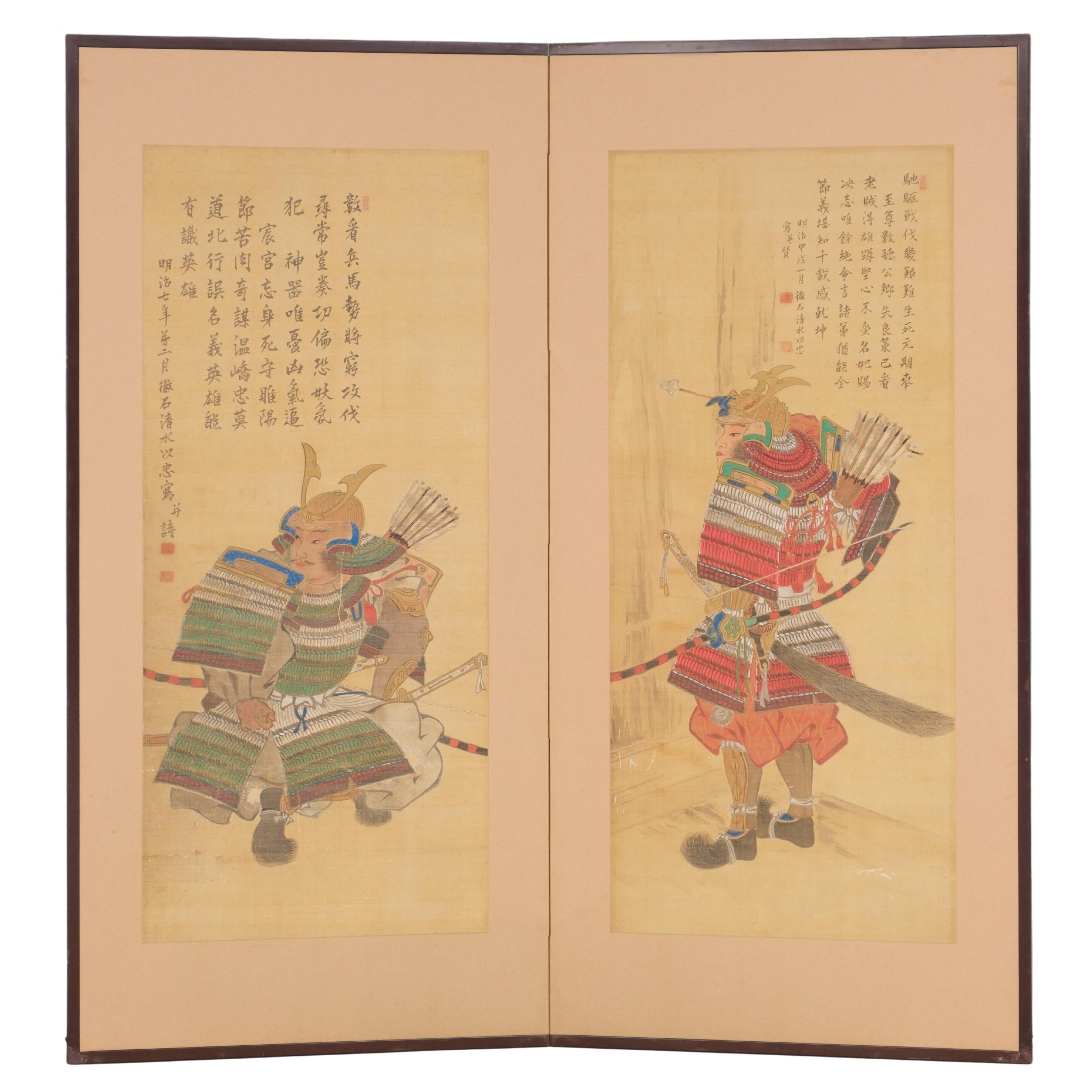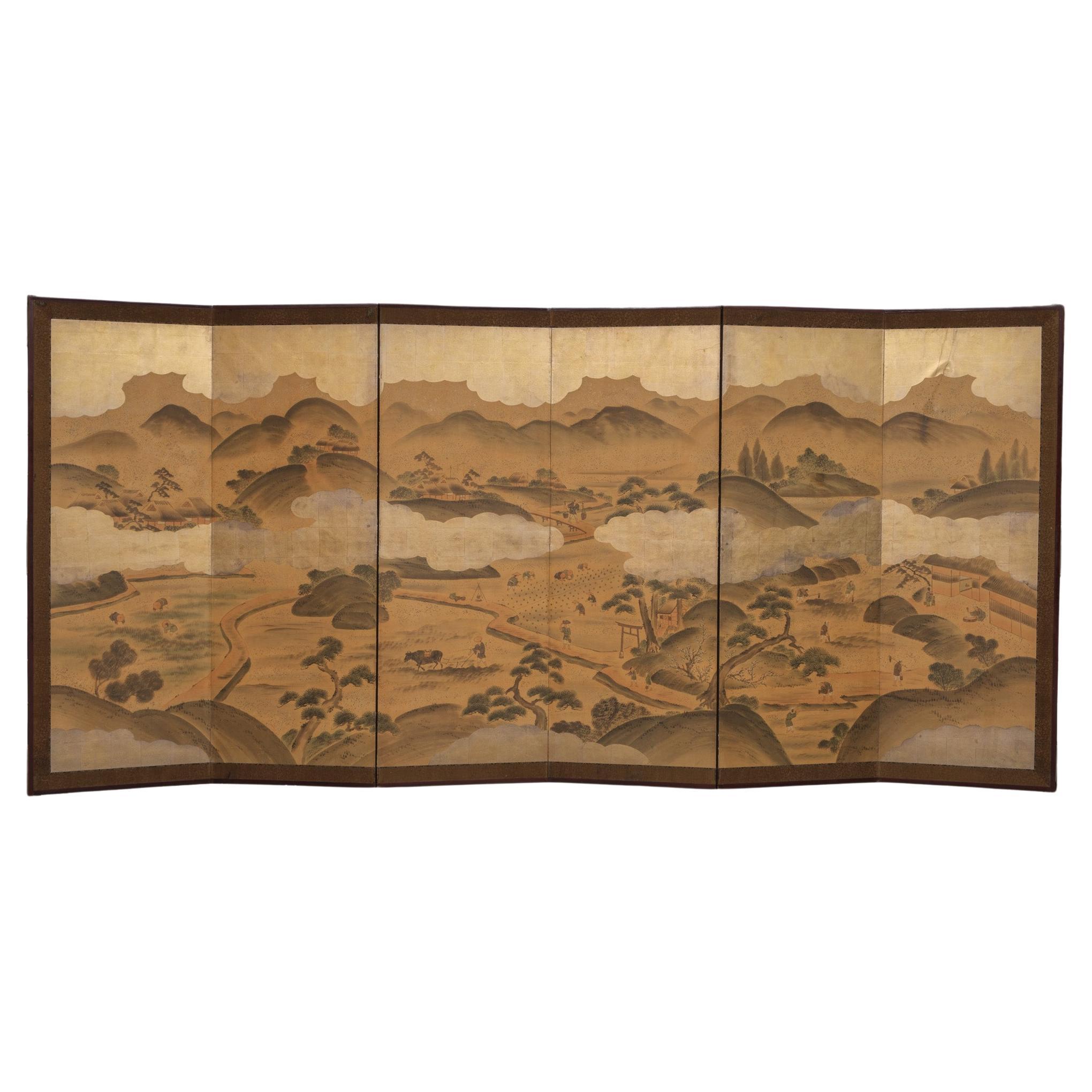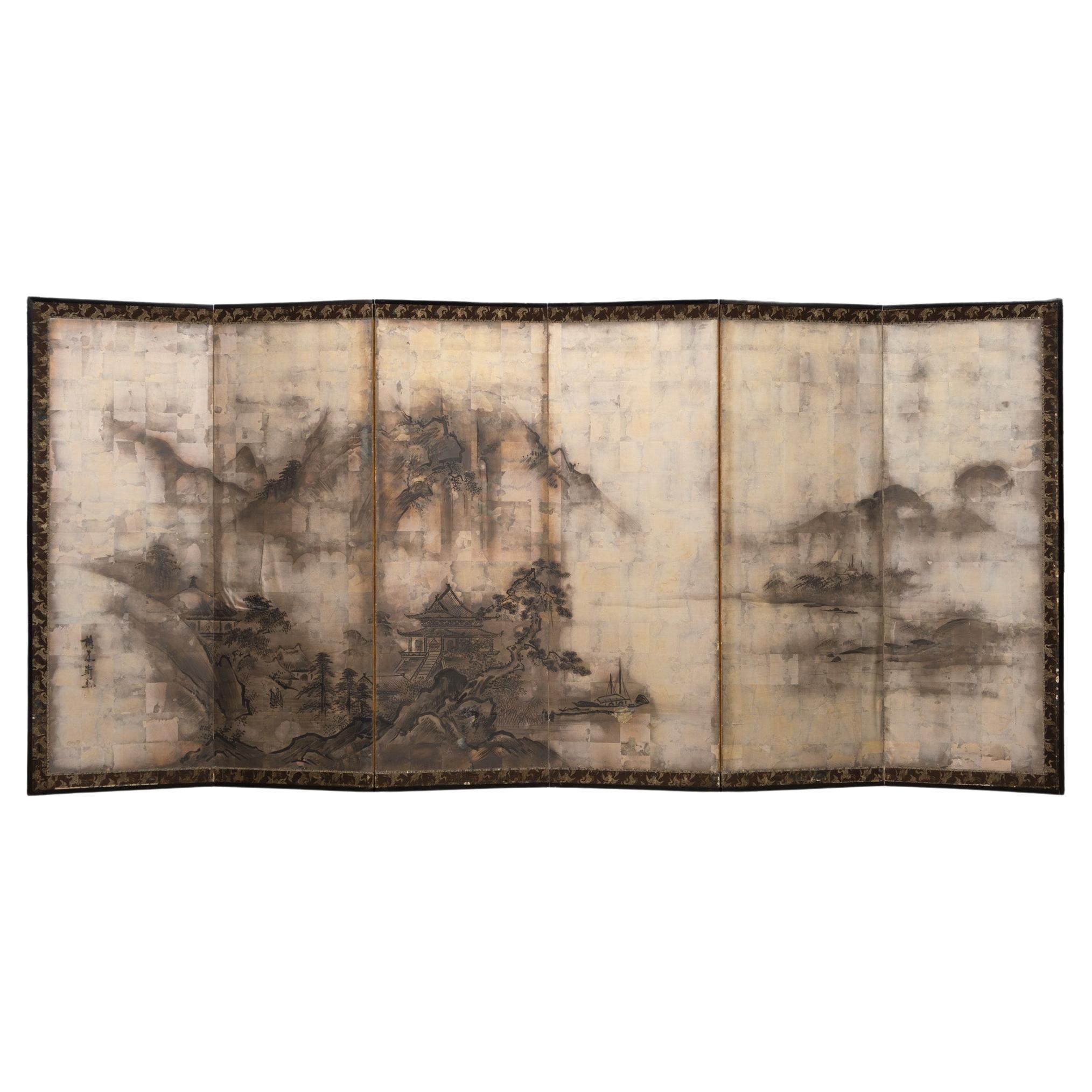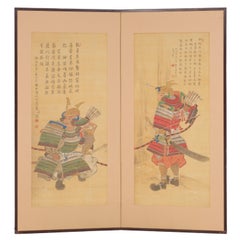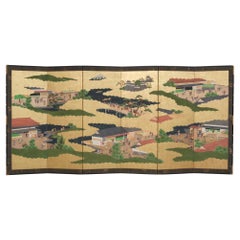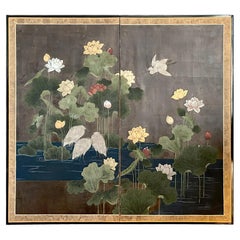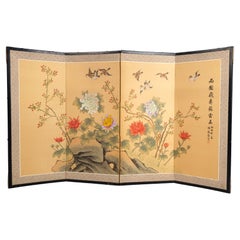Items Similar to Tall, Japanese lacquer byôbu 屏風 (folding screen) by Mitsuo Takana 高名光夫 (1956)
Want more images or videos?
Request additional images or videos from the seller
1 of 19
Tall, Japanese lacquer byôbu 屏風 (folding screen) by Mitsuo Takana 高名光夫 (1956)
About the Item
Refined, tall two-panel byôbu (folding screen) completely adorned with ‘Wajima Ryûsaku’ lacquer by the Nitten award winning artist Mitsuo Takana (1956).
Featuring five refined images inspired by woodblock prints from the famous series ‘Tôkaidô gojûsan tsugi’ (The fifty-three stations of the Tokaido road), like the 1st station Nihonbashi, the 10th station Hakone, and the 21st station Okabe.
The design is executed in hiramaki-e (low-relief lacquer design) in shades of gold, silver, heightened by some multi-coloured details. Set on a shiny black lacquer substrate.
Signed in red lacquer in the lower right corner.
Including original signed & sealed wooden tomobako (storage box). The front with an inscription about the contents as described above. The inside:
‘Friend of the Nitten Exhibition Takana Mitsuo’ - Seal: ‘Hikari’.
‘Lacquer artist Wajima Ryûsaku’ - Seal: ‘Ryûsaku’.
Mitsuo Takana was born 1956 in Wajima, Ishikawa prefecture. He won several awards during exhibitions like: Ishikawa Contemporary Art Exhibition, Japan Artisans' Association Exhibition and the well-known Nitten Exhibition.
Dimensions:
Height 57.48 in/146 cm, Total width 66.92 in/170 cm (2 x 33.46 in/85 cm), Depth 1.10 in/2.8 cm.
Weight 56.21 lb/25.5 kg.
Wajima lacquerware, known as Wajima-nuri in Japan, is a distinct form of traditional lacquerware crafted in the city of Wajima, Ishikawa prefecture. Renowned for its exceptional beauty and durability, Wajima lacquerware stands out due to its unique technique of layering multiple coats of urushi (lacquer) mixed with powdered diatomaceous earth, known as jinoko. This special undercoating, applied meticulously onto delicate zelkova wooden substrates, not only enhances the longevity of the lacquerware but also gives it a distinct luster and resilience. With its exquisite craftsmanship and use of locally sourced materials, Wajima lacquerware continues to be cherished as a treasured Japanese art form.
When shipped we will add a certificate of authenticity.
Price including insured shipping.
Due to the delicacy and weight of this piece, a custom-made wooden crate will be made for transport
- Creator:Mitsuo Takana (Artist)
- Dimensions:Height: 57.49 in (146 cm)Width: 66.93 in (170 cm)Depth: 1.11 in (2.8 cm)
- Materials and Techniques:
- Place of Origin:
- Period:
- Date of Manufacture:Heisei period (1989-2019)
- Condition:Wear consistent with age and use. In a very good original. Please look at the photos for a clear condition reference.
- Seller Location:Amsterdam, NL
- Reference Number:Seller: B44201stDibs: LU7165238964762
About the Seller
5.0
Vetted Seller
These experienced sellers undergo a comprehensive evaluation by our team of in-house experts.
Established in 1996
1stDibs seller since 2022
16 sales on 1stDibs
Typical response time: 4 hours
- ShippingRetrieving quote...Ships From: Zwanenburg, Netherlands
- Return PolicyA return for this item may be initiated within 14 days of delivery.
Authenticity Guarantee
In the unlikely event there’s an issue with an item’s authenticity, contact us within 1 year for a full refund. DetailsMoney-Back Guarantee
If your item is not as described, is damaged in transit, or does not arrive, contact us within 7 days for a full refund. Details24-Hour Cancellation
You have a 24-hour grace period in which to reconsider your purchase, with no questions asked.Vetted Professional Sellers
Our world-class sellers must adhere to strict standards for service and quality, maintaining the integrity of our listings.Price-Match Guarantee
If you find that a seller listed the same item for a lower price elsewhere, we’ll match it.Trusted Global Delivery
Our best-in-class carrier network provides specialized shipping options worldwide, including custom delivery.More From This Seller
View AllTall Japanse 2-panel byôbu 屏風 (folding screen) with samurai
Located in Amsterdam, NL
Striking tall two-panel byôbu (folding screen) covered with a pair of separate hanging scroll paintings (kakejiku) depicting samurai (warriors) paired with poems. The one on the righ...
Category
Antique 1870s Japanese Paintings and Screens
Materials
Silk, Wood, Paper
Large Japanese 6-panel byôbu 屏風 (folding screen) with chrysanthemum garden
Located in Amsterdam, NL
A very colourful and captivating large six-panel byôbu (folding screen) with a refined continuous painting of a luscious flower garden filled with many different types of chrysanthemums (kiku), next to a winding river.
This multi-coloured painting is set on a shiny gold-leaf background, and the chrysanthemum flowers are painted by using shell paste (gofun) in low relief.
Several clutches with a great variety of chrysanthemum flowers are in full bloom and they each show their unique form and colour. Varying from white, red, yellow and pink. The flowers bloom all around and on different kinds of bamboo fences and trellises.
In Japan chrysanthemums are believed to represent happiness, love, longevity and joy.
The panels are surrounded by two silk borders, a thin black one, and a wide brown one. The screen is protected by a black and red negoro’nuri...
Category
Antique Late 19th Century Japanese Paintings and Screens
Materials
Gold Leaf
Large Japanese 6-panel byôbu 屏風 (folding screen) with genre painting
Located in Amsterdam, NL
Fascinating large six-panel byôbu (folding screen) with a detailed genre painting on goldish silver leaf with different scenes of people at work in a rural mountain village during th...
Category
Early 20th Century Japanese Paintings and Screens
Materials
Silver Leaf
Large Japanese 6-panel byôbu 屏風 (folding screen) with Edo genre painting
Located in Amsterdam, NL
Remarkable and large six-panel byôbu (folding screen) with a detailed genre painting on gold leaf of different scenes of the town Yoshida, one of the Tôkaidô road stations. It shows ...
Category
Antique Early 19th Century Japanese Paintings and Screens
Materials
Metal, Gold Leaf
Large Japanese byôbu 屏風 (folding screen) with Nanga School-style painting
Located in Amsterdam, NL
A captivating large six-panel byôbu (folding screen) with a refined Nanga School-style painting of a peaceful mountain landscape along a river. A large Chinese pavilion sits at the base of a tall towering cliff, next to a large curving pine tree (matsu). A junk with fishing nets is docked near the complex.
This pavilion is looking over a small village in the distance, where several thatched roofs an figures are visible.
Across the wide river, even the rooftops of the next village can be seen.
This painting is made using black ink (sumi) on an goldish oxidized silver leaf background.
Silver leaf continuously undergoes the process of oxidation, which creates a beautiful aged patina.
The screen is signed in the lower left corner by an artist named Kômokuken.
Mounted by two silk borders, a thin blue and white one, and a broad brown one with a crane motif. Protected by a black lacquer frame with original hardware.
Dimensions:
Total width: 145.51 in/369.6 cm (2 x 24.80 in/63 cm, 4 x 23.97 in/60.9 cm), Height: 68.11 in/173 cm.
The folding screen is ideal for mounting flat on a wall and presenting as a single work of art.
Nanga ( "Southern painting...
Category
Antique Late 19th Century Japanese Paintings and Screens
Materials
Silver Leaf
Large Japanese 6-panel byôbu 屏風 (folding screen) of perched taka 鷹 (hawks)
Located in Amsterdam, NL
Wonderful large six-panel byôbu (folding screen) covered with six separate hanging scroll paintings (kakejiku) depicting different taka (hawks) perched on rocks and branches situated...
Category
Antique Early 19th Century Japanese Paintings and Screens
Materials
Silk, Wood, Lacquer, Paint, Paper
You May Also Like
Japanese Folding Screen "Byobu" from the Edo Period
Located in Paris, FR
Japanese Screen "Byobu", from the Edo period (circa 1800), with two leaves in silk paper mounted on canvas with leather background.
Beautiful floral decoration "Rimpa" with wading bi...
Category
Antique Early 19th Century Japanese Edo Paintings and Screens
Materials
Canvas, Paper
Japanese Four-Panel Folding Screen Byobu Signed Showa Period C.1950
Located in London, GB
A four-panel Japanese Byobu folding screen depicting a floral scene with birds.
Japan, C.1950 Showa Period
An attractive example, beautifully h...
Category
Mid-20th Century Japanese Showa Paintings and Screens
Materials
Silk, Paper
$1,312 Sale Price
20% Off
Japanese Chinese Asian Large Six-Panel Folding Byobu Screen Mythical Lanscape
Located in Studio City, CA
A gorgeous, strangely beautiful, unusually engaging, and alluring hand-painted large six-panel Japanese/Asian Byobu folding screen depicting an almost magical/ mythical nature scene ...
Category
Antique 18th Century Japanese Edo Paintings and Screens
Materials
Gold Leaf
Japanese Asian Signed Four-Panel Byobu Folding Screen Winter Nature Landscape
Located in Studio City, CA
A gorgeous hand-painted four-panel Japanese/Asian Byobu folding screen depicting a stark winter nature landscape scene with barren trees, rolling snow-filled hills, and a frozen lake. The deep, rich blacks-whites and grays, beautiful composition, and hand-painted detail make this an attractive and special work. We have not come across another screen quite like this one. The work is very reminiscent of Japanese artist Kiyoshi Saito's Winter in Aizu...
Category
Mid-20th Century Japanese Showa Paintings and Screens
Materials
Silk, Wood, Paint
Japanese Asian Signed Six-Panel Folding Byobu Screen of Playful Court Scene
Located in Studio City, CA
A gorgeous, quite fascinating hand-painted six-panel Japanese Byobu folding screen depicting a rather engaging androgynous or erotic court scene (it has been suggested to us that thi...
Category
Mid-20th Century Japanese Showa Paintings and Screens
Materials
Gold Leaf
Japanese Chinese Asian Two-Panel Byobu Folding Screen Ancestral Immortal Figures
Located in Studio City, CA
A gorgeous, quite large, boldly colored, and alluring hand-painted two-panel Chinese/Japanese/Asian Byobu folding screen depicting 18 exquisitely clad male ancestral or immortal figu...
Category
20th Century Paintings and Screens
Materials
Gold Leaf
Recently Viewed
View AllMore Ways To Browse
Wooden Screen
Wooden Screens
Black Lacquer Screen
Black Lacquered Screen
20th Century Folding Screen
Wood Crate Box
Asian Art Folded Painting
Asian Folding Screens
Artist Wooden Box
Wooden Screen Panels
Asian Wooden Panels
Black Lacquer Asian Painting
Asian Screen Black Lacquer
Wooden Asian Screens
Asian Box On Stand
Wooden Folding Screen
Byobu Panel
Byobu Screens
